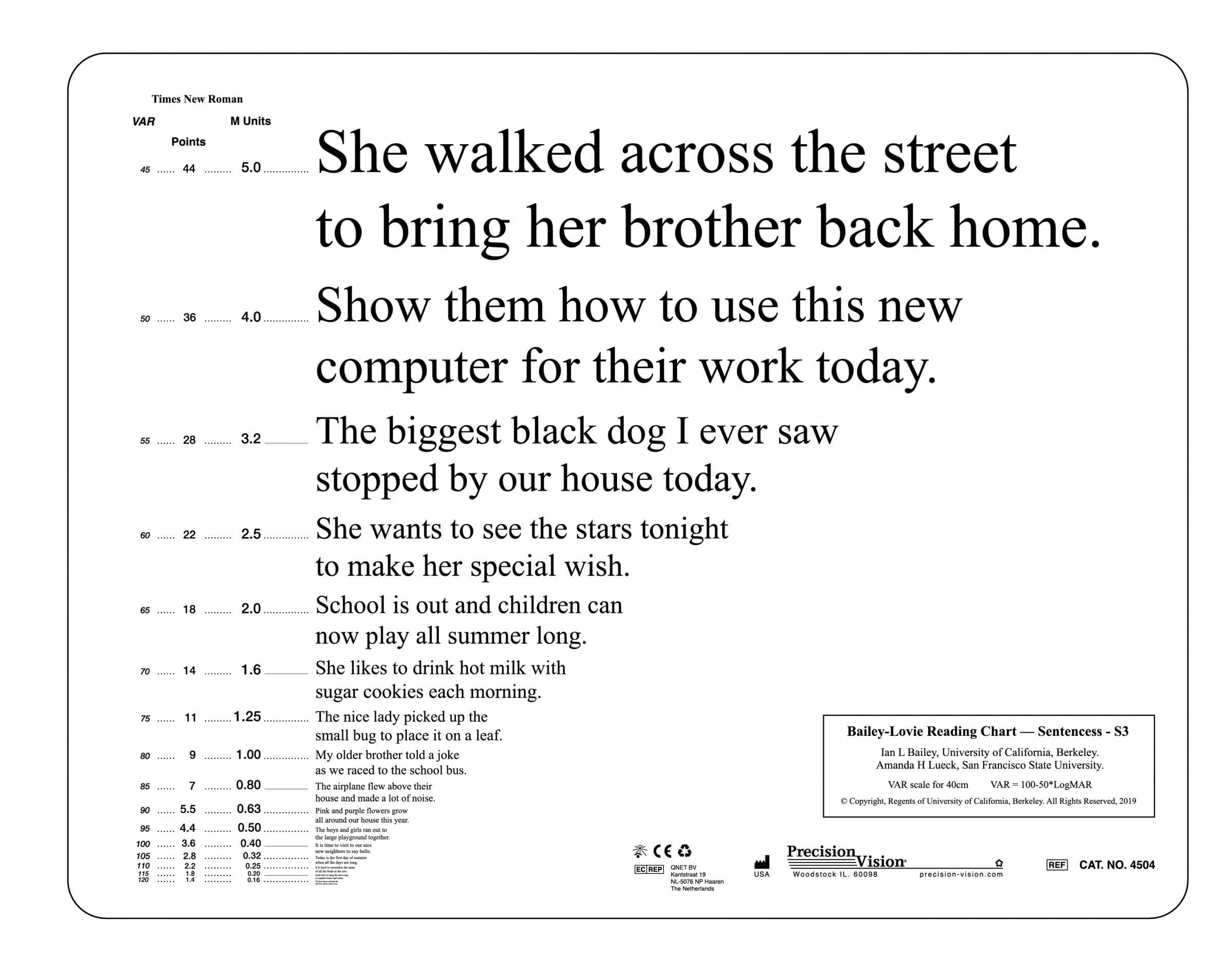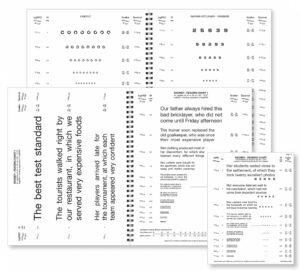Bailey-Lovie Reading Charts
Reading Chart with unrelated simple sentences or words of equal length and difficulty.
Designed by Dr. Ian Bailey (University of California, Berkeley) and Dr. Amanda H. Lueck (San Francisco State University).
Notations included: VAR at 40 cm, Points, and M Units (5.0 to 0.16)
$38.00
Product Variations
Description
This new set of Bailey-Lovie 2019 reading charts follow the design principles from the original Bailey-Lovie.
The Bailey-Lovie principles ensure that the visual task remains essentially the same at each size level. That is, from one size level to the next, size is the only significant variable. This requires a logarithmic (constant ratio) progression of print size, and a standardized layout at each size level. (same number of letters or words, same spacing ratios, same number of rows, same font,). With reading charts, the words and sentences, paragraphs or passages should be chosen or designed so that the content and difficulty of the reading task has minimal variation from one size sample to the next. One major advantage of charts with these design characteristics is that the standardization of the task facilitates the assessment of reading speed as a function of print size.
Word & Sentence Reading Charts
The charts may be used for measuring reading acuity and for testing reading speed as a function of the size of the print.
Sentences are more representative of real-world reading tasks than are the sets of unrelated words.
One can think of the sentence-reading charts as mainly testing the ability to read, and the word-reading charts as mainly testing the ability to see to read.
Chart design
These charts are in the English language.
The Word charts use unrelated words and, at each size level, there are 10 words arranged in two rows.
The Sentence charts use sentences that have 60-character spaces arranged in two rows.
The words and sentences are at the third-grade level and they were selected or composed by schoolteachers.
The layout has left justification and there is close spacing from one size level to the next.
The size progression is in increments of 0.10 log units (ratio ≈ 1.26).
The font is Times New Roman and the sizes range from 5.0 M to 0.16 M (44 to 1.4 points).
Print sizes are labeled in M-units (the distance in meters at which the lower-case letters subtend 5 arcminutes) and in typography points.
There are also VAR labels for designating visual acuity and these have been calibrated for a viewing distance of 40 cm.
Visual acuity demands for reading typeset materials depend on print size and viewing distance
Visual acuity is an angular measurement. When measuring reading acuity, the visual acuity scores depend on both the size of the print and the viewing distance.
When considering reading speed as a function of print size, the primary variable is the angular size of the print.
Thus, it is important to note the viewing distance(s) as well as the height(s) of the print being read.
Good focus should be maintained.
When testing reading performance, the test cards are at near and vision should be in good focus.
Young patients usually have sufficient accommodation to achieve in-focus vision for most viewing distances.
Older patients often require a reading addition, or a combination of add power and accommodation, in order to achieve good focus.
If changes in viewing distance are permitted, lens changes may be necessary to maintain good focus.
Most, but not all, testing of reading speed as a function of print size is performed with the test card at a fixed distance.
Reading Speeds
The Bailey-Lovie charts are designed so the patient can read without pausing as they go from one size level to the next.
Reading in this continuous style improves the precision of timing the reading performance because it avoids the uncertainty or “noise” associated with the patient beginning and ending each reading task.
Reading speeds can be measured in several different ways. Patients may be instructed to read silently or aloud.
Reading efficiency as a function of print size.
For silent reading, speeds may be monitored objectively using eye-movements.
Readings speeds are usually significantly faster for reading silently than for reading aloud.
Eye-movements can be monitored electronically so that each eye-movement is recorded.
Large right-to-left return saccades mark the end of reading of one row of print and beginning the next.
With two rows of print at each size, the time taken to read each print sample will be the time between two successive return saccades.
From eye-movement recordings, times to read each print size is easily measured and reading speeds can be calculated.
A similar, but less precise approach is for the clinician to watch the eye-movements as the patient reads aloud.
Using a stop-watch in lap-time mode, the clinician can see the return saccades, record times and determine reading speeds for the different size levels.
A simpler method is for the clinician to listen to the patient reading aloud, and use a stopwatch in lap-time mode, pressing the button each time the patient reads out the last word of each print-size sample.
Perhaps the most common clinical practice is for the clinician make to subjective qualitative judgments about reading efficiency and the confidence that patient exhibits as they read at each print size. The clinician hears the pattern of the reading becoming slower and the confidence diminishing as the print size approaches the patient’s resolution limit.
At large print sizes, patients may read with their maximum efficiency, but as the print size progressively becomes smaller, the reading efficiency systematically declines and reading speeds becomes slower.
Reading times and words per minute
Most smart-phone devices have a clock function that includes a lap-timer. Stop-watches are inexpensive.
Electronic timers in lap-time mode can give a list of the times taken between consecutive button presses.
Typically, with these reading charts, the timer will show a list of the times taken to read the print at each size level.
The times can easily be converted to reading speed expressed in words per minute.
On the word-reading chart, there are 10 words on the word-reading chart at each size level.
On the sentence reading chart there are 60-character spaces, and it is common practice to assume that 6 characters represent a standard-length word. Each sentence can be considered to be equivalent to 10 words.





